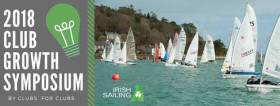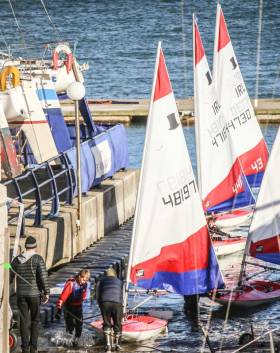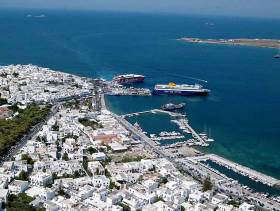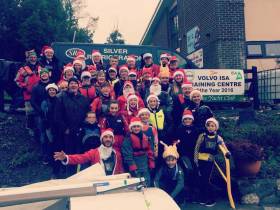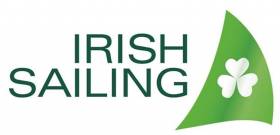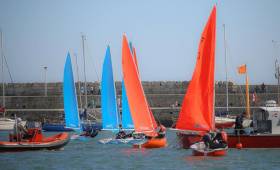Displaying items by tag: Irish Sailing
How To Go Sailing For The Leaving Cert
#Sailing - With sailing being included as Physical Education is added to the Leaving Certificate next September, Irish Sailing is encouraging parents to urge their schools to apply for the first phase of the new curriculum.
Participating schools have three options to choose from, including Physical Education as an exam subject and as a non-exam framework for the Senior Cycle.
Among the six main ‘physical activity areas’ denoted for the new curriculum, sailing is listed under ‘Adventure activities’ along with canoeing/kayaking and rowing/sculling.
Interested schools are also encouraged to get in touch with their local sailing club for advice via Irish Sailing’s regional development officers.
The closing date for applications for the Phase 1 School Selection survey is Tuesday 16 January 2018.
New Symposium to Increase Participation in Sailing
A one day symposium will be held by Irish Sailing in January to seek ways in which sailing clubs could all collectively support each other, in collaboration with Irish Sailing, to increase participation in the Sport.
Facilitated ‘by volunteer club members, for volunteer club members’, to challenge and share how we could “Think outside the Box?” and ways to grow club sailing.
The event will be chaired by IS board member Nikki Curran from Sligo Yacht Club.
A team of passionate volunteers from various Clubs throughout the country, Elaine O'Mahony of Foynes, Colin Moorehead of Cork, Donnchadh Mac Cobb of Poolbeg and George Kingston of Kinsale and Dun Laoghaire, came up with a simple but stimulating idea.
The theme is simple and will build on the experience and professionalism that is vibrant among volunteers throughout the Clubs in Ireland.
The symposium will allow everyone to share their ideas and concerns in a workshop format and there will be various different opportunities for people to network and identify key collaborations to work on together with Irish Sailing ahead of the 2018 season. The date was set as early as possible after the traditional changing of new committees for Saturday 27 January and is on in The Plaza Hotel Tallaght. This is a free event with free tea ‘n coffee throughout the day and a discounted corporate lunch available starting off at €7 for soup ‘n sandwich and dinner for €13.
For further details, timetable and to book your place please click here
Irish Sailing Encourages Yacht Clubs To Spend Sports Capital Grant At Home
Irish Sailing is encouraging yacht and boat clubs who won over €1.1m in Sports Capital grants in November to try to spend the money in Ireland.
In the interests of 'supporting the Irish Boating industry', Irish Sailing has appealed to clubs to 'seek quotes from local suppliers and help to support the Irish Marine industry'.
Of the €1.1 million, awarded to clubs, Irish Sailing estimate approximately €750k will be spent on boats and equipment.
See the full list of clubs and awards as previously reported by Afloat.ie here
'The Sports Capital support for Irish Sailing clubs is brilliant for club development and creating new opportunities. If every club then bought from an Irish broker the knock on effect to the Irish marine industry would be tremendous' Irish Sailing CEO, Harry Hermon, told Afloat.ie.
'Our industry is a close knit community that offers an incredible support to the boating community – lets help keep the cogs oiled', he added.
30 sailing clubs throughout the country will share over a million in funding.
Dun Laoghaire's National Yacht Club on Dublin Bay is one of the biggest sailing club recipients with a grant of €142,375 for Increasing women and teenagers participation in the sport. The east pier club is the home of Rio Olympic silver medalist Annalise Murphy.
Also in Dun Laoghaire, the country's bggest sailing centre, the Irish National Sailing Club (Locaste) got €40,058 for the renewal of sailing equipment and the purchase of new boats.
The Royal St. George Yacht Club (RSGYC) got €31,228 for a Firefly dinghy renewal programme, Dun Laoghaire Motor Yacht Club got €18,515 for the purchase of a 5m RIB and capstan winch. The Royal Irish Yacht Club got €25,000 for its safety and support fleet. Dublin Bay Sailing Club got €11,236
Sailing Clubs Benefit in Sports Capital Grants: €1m to 30 Clubs Across the Country
Irish sailing clubs are among 1,700 sports clubs nationwide receiving €56m in the latest round of sports capital grants, it was confirmed this morning. (Download the full list of grants awarded below).
30 sailing clubs throughout the country will share over a million in funding.
Dun Laoghaire's National Yacht Club on Dublin Bay is one of the biggest sailing club recipients with a grant of €142,375 for Increasing women and teenagers participation in the sport. The east pier club is the home of Rio Olympic silver medalist Annalise Murphy.
Also in Dun Laoghaire, the country's bggest sailing centre, the Irish National Sailing Club (Locaste) got €40,058 for the renewal of sailing equipment and the purchase of new boats.
The Royal St. George Yacht Club (RSGYC) got €31,228 for a Firefly dinghy renewal programme, Dun Laoghaire Motor Yacht Club got €18,515 for the purchase of a 5m RIB and capstan winch. The Royal Irish Yacht Club got €25,000 for its safety and support fleet. Dublin Bay Sailing Club got €11,236
In Cork Harbour, Royal Cork Yacht Club were awarded €13,000 for support craft for teaching water sports
The programme is the primary means of providing Government funding for capital projects to sport and community organisations at local, regional and national level.
'This funding will give make a considerable impact on access to sailing in regional clubs, as well as help develop and improve sailing facilities. The pay back is the physical and mental benefits of sailing to local communities, ' according to an Irish Sailing spokesperson.
The 2017 round for applications closed in February with a record number of 2,320 received.
Around the coast – and on lakes and rivers too – sailing clubs shared in the distribution of the captial funds.
In Limerick, Foynes Yacht Club was awarded €16,500 for Physically Disabled Sailing. Sligo Yacht Club got €8,000 for its 'Try A Sail' and 'Inclusion for All' project.
In Tipperary, Lough Derg Yacht Club was awarded €4,000 for its access for all programme.
In Westmeath, Lough Ree Yacht Club got €12,500 to replace destroyed electrics and to buy two boats.
In West Cork, Glandore Harbour Yacht Club has €16,000 for a new clubhouse roof & canopy.
Minister Shane Ross said at the announcement: "This is a great day for Irish sport. When we originally invited applications under the scheme, we had just €30m to allocate and the record level of applications would have left a large number of good projects unsupported and many clubs disappointed.
"Happily, following the conclusion of budget discussions, I was delighted to secure the required additional resources to enable me to allocate €56m in total to local sports clubs and organisations throughout the country.
"The net result of this is that we are able to provide financial assistance towards over 1,700 different projects all over the country.
"The benefits of participating in sport are well documented, for both physical and mental health, and these new grants for local clubs will help us in our overall objective of getting as many people participating in sport as possible.
"The grants are also excellent news for our communities both rural and urban, as club sport is a superb way to bolster local pride, affinity and inclusion."
A further €4m has been set aside for regional grants. These allocations are expected to be announced in the coming weeks.
| Killaloe Sailing Club | Sail Training Dinghies for Children and Teenagers | €6,000 |
| Bantry Bay Sailing Club Bantry Bay Sailing Club | Club Development | €23,000 |
| Bere Island Projects Group Ltd | Bringing Sailing back to Bere Island | €11,000 |
| Glandore Harbour Yacht Club | New clubhouse roof & canopy over adjacent yard | €16,000 |
| Kinsale Yacht Club Company Ltd | Rigid Inflatable boat (RIB) for training & safety | €8,000 |
| Monkstown Bay Sailing Club | Changing rooms renovation & engine upgrade | €8,000 |
| Royal Cork Yacht Club | Support Craft for teaching water sports | €13,000 |
| Schull Harbour sailing Club Ltd S | RIB – Dinghy Sailing & Cruiser Crewing | €18,000 |
| Clontarf Yacht & Boat | Club upgrade facilities for equality of access at CYBC | €136,943 |
| Dublin Bay Sailing Club | Sports Equipment | €11,236 |
| Malahide Yacht Club | Essential Rescue Equipment | €61,200 |
| Poolbeg Yacht and Boat Club | Dublin City Community Sailing | €150,000 |
| Royal Irish Yacht Club | Safety and support fleet | €25,000 |
| Rush Sailing Club | Expansion & Refurb of changing & toilet facilities | €130,381 |
| Sailing in Dublin Club Ltd | Keelboat for racing and training | €20,000 |
| The National Yacht Club | Increasing Women and Teenagers participation | €142,375 |
| The Royal St. George Yacht Club RSGYC | Club Firefly Dinghy Renewal | €31,228 |
| Galway Bay Sailing Club Ltd | RIB Purchase | €14,000 |
| Galway City Sailing Club | Sailing dinghies & Safety Boat for shared sailing | €17,500 |
| Foynes Yacht Club | Sailing in Foynes for Physically Disabled | €16,500 |
| Oriel Sailing Club | Purchase of sailing equipment | €6,000 |
| Mullaghmore Sailing Centre ltd. | Sailing boatsRescue boat engines, Club Refurb. | €11,500 |
| Sligo Yacht Club Ltd | ‘Try A Sail’ and Inclusion for All, Project | €8,000 |
| Lough Derg Yacht Club | School sailing and access4all programme | €4,000 |
| Waterford Harbour Sailing Club | New Rescue/Safety RIBs & Dinghies | €34,000 |
| Lough Ree Yacht Club | Replace Destroyed Electrics. Buy 2 Boats | €12,500 |
| Blessington Sailing Club | Community growth project | €15,000 |
| Bray Sailing Club | Growing sailing in the community | €19,591 |
| Greystones Sailing Club | Development boats | €10,000 |
| Wicklow Sailing Club | Rescue Craft and Storage | €46,000 |
| €1,025,954 |
New Boating Taxes in Europe Highlighted by Irish Sailing & the EBA
Increased taxes on leisure boating are becoming more of a reality in European waters, according to Irish Sailing and the European Boating Association (EBA) that list two new taxes for 2018.
In Greece, for example, a tax on boating has been a possibility for a number of years, however recent communications indicate that it is increasingly likely that this tax will come to fruition in 2018.
In very basic terms this tax will see owners that keep their boats in Greece paying an amount based on the length of the boat which for a 7 – 8 metre boat is likely to be around €16 per month increasing to €8 per metre per month for boats of more than 12 metres in length.
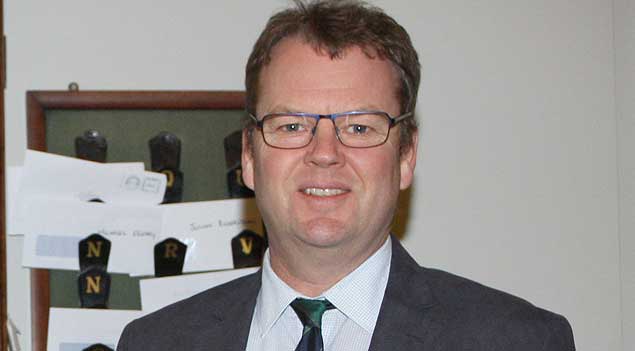 Harry Hermon represents Irish Sailing Interests at the EBA
Harry Hermon represents Irish Sailing Interests at the EBA
Irish Sailing CEO Harry Hermon, who sits on an EBA committee to monitor EU legislation that could restrict boating activity, says: 'We're keeping a close eye on this [Greek tax] to try and ensure it doesn’t reach into Ireland'.
In a separate development, a significant increase to the Croatian Sojourn tax is planned for 2018 which will in the worst cases will increase by over 400% for an annual payment. The Sojourn Tax is payable by all boaters in Croatia and was last set in 2013 when Croatia acceded to the EU.
A Festive End to Foynes Sailing Season on the Shannon Estuary
Foynes Yacht Club on the Shannon Estuary finished on a high for the 2017 season just in time for Christmas with a festive theme for the final day of Sylver Refrigeration Open Dinghy November Series running every Sunday in the month. Organisers have been very lucky with the weather completing the full race programme of the Series which was preceded by an equally successful October Dinghy Series.
The club continues to be a hive of activity throughout the sailing season with dinghy racing opening the season in February and March and closing the season in October and November. In the summer months Cruiser Racing takes over with most of the dinghy sailors switching to a full calendar of events at club, regional and national level. Some of the cruiser fleet travelled far and wide with Big Deal competing at a number of international events, their best result winning the Dún Laoghaire to Dingle Double Handed Category, while the J24 Stouche was the first ever west coast boat to win their class the Irish Cruiser Racing National Championships in Cork.
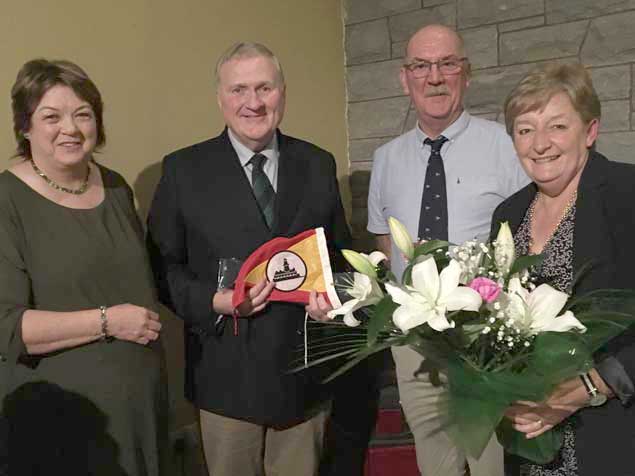 Irish Sailing President Jack Roy (second from left) is presented with the Foynes Yacht Club burgee by Commodore James McCormack. Also pictured are Patricia McCormack (left) and Rosemary Roy at the 2017 Laying–up supper
Irish Sailing President Jack Roy (second from left) is presented with the Foynes Yacht Club burgee by Commodore James McCormack. Also pictured are Patricia McCormack (left) and Rosemary Roy at the 2017 Laying–up supper
The Foynes Sailing Academy has gone from strength to strength with increasing numbers participating each year. FYC have invested year on year in safety equipment, boats and facilities and was described earlier this year by one of Irish Sailing’s Regional Development Officers as a Centre of Excellence. In 2017 the club’s sailing camps completely booked out and saw an increase in group bookings from school and scout groups. The Sailing Academy have placed a strong emphasis over the past few years in helping interested young sailors to follow the instructor pathway and this year for the first time all instructors that worked at the Academy were ‘home grown’.
At the recent Laying Up Supper of the club with over 130 in attendance Jack Roy, Irish Sailing President, spoke of the importance of volunteerism within the club structure. Commodore James McCormack paid tribute to the club members in particular the juniors who are doing the club so proud at club, local, regional, national and international level and to every member of the club throughout the year that have given their time freely for the benefit of the club.
The final instalment of the new pontoons built by the members will be in place next February, a magnificent achievement for the club, lead by James McCormack and John Joe Buckley and just in time for the start of a busy 2018 which will see the club host the Munster Mermaid Championships on the June 2nd/3rd, the J24 National Championships on June 8th to 10th and the Mermaid National Championships from August 2nd to 5th.
Irish Sailing now says that the independent external investigation into the Optimist Squad incident in Dun Laoghaire that was initially due for publication in mid-November will now be published in December.
Irish Sailing President Jack Roy says he expects that the investigation, having reviewed every aspect of the incident, will result in recommendations which, once implemented, will reduce the likelihood of a recurrence of an event such as this.
In an update on progress, Roy explained the delay in publication is due to the extent of the investigation by the independent investigator Philip Scallan and Ger Keeling.
‘Completing this report has taken longer than expected because time had to be allowed to interview all those who wished to contribute. I am confident its recommendations will lead to a safer sport for all of us’, Roy said.
President’s Blog: Looking Back on a Very Active Irish Sailing Season
As we head into the winter I’m not just looking back on a very active calendar of sailing, but also looking forward to our winter schedule writes Irish Sailing President Jack Roy.
I’ve travelled around the country extensively these last few months, and seeing the number of boats on the water as well as the obvious optimism and enthusiasm, is fantastic. Volunteers remain the pivoting factor to the success of so many events. From those hosted by the larger yacht clubs like the Volvo Dun Laoghaire Regatta, one of the largest events in Europe this season, to the Sovereign’s Cup in Kinsale or the ICRA Championships in Crosshaven, to WIORA hosted by Club Seoltóireacht Árann on Inis Mór, Glandore YC’s Classic Regatta, and Calves Week organised by Schull SC, to numerous dinghy Regional and National Championships, it’s been a great season. All around the country, with the backing of sponsors at all levels, clubs are providing great sailing, training, competition, enjoyment and the all-important “fun” which is key to our sport.
The culmination of this event-filled summer came in October with the hosting of our All Ireland Sailing Championships in Mullingar Sailing Club. This unique event, now in its 70th year, saw sixteen of our national champions race against each other in this year’s chosen boat, the GP14. A very pleased Fionn Lyden, of Baltimore Sailing Club, was the winner of a tense and close fought competition beating the defending champion Alex Barry into second place. Fionn now joins Alex and a long list of previous champions, from Anthony O’Leary and Nicholas O’Leary in recent years through to Olympic veterans Mark Mansfield and Mark Lyttle. The talent coming up through the ranks was represented the week before at the Junior All Ireland Sailing Championships at Fastnet Marine Outdoor Education Centre, where local Cork sailor Micheal O'Suilleabhain of Kinsale Yacht Club claimed the title.
The inaugural Watersports Inclusion Games in June in Dun Laoghaire saw 80 volunteers providing activities for over 220 participants with various abilities on the physical, sensory, intellectual and learning difficulty spectrums. The participants and their families had a chance to try sailing, rowing and canoeing, and showcased how sailing really is a sport for all and a sport for life. The Games were such a success that we’ve been shortlisted for the annual CARA Inclusion Awards.
Internationally too Irish sailors are making an impact. Currently competing in the Volvo Ocean Race are Damian Foxall in his sixth race, on board Vestas 11th Hour, while Annalise Murphy sails her first race joining the crew of Turn the Tide on Plastic. We’ll be profiling all Irish involvement in the race on our website over the coming weeks.
As I write this blog, Tom Dolan is currently lying fifth in the Mini Transat Race. This is going to be an exciting race to follow over the coming days as the race reaches its climax, finishing in Martinique. Tom is aiming for a podium finish which now looks very achievable. Good luck Tom from all of us!
Irish Sailing Gets Two More International Judges Appointed at World Sailing Conference
The Irish Team Racing Association (ITRA) has been one of the first organisations to congratulate two new IRL International Judges appointed at the recent World Sailing Conference in Mexico.
Both successful candidates have close links with team racing.
Cxema Pico is a leading Irish team racing umpire and current Treasurer of the Irish Team Racing Association. He is also well known for his activities with ICRA. Cxema is based in Greater Dublin.
Chris Lindsay, from Carrickfergus, is a leading umpire in the UK, where he is doing research for his PhD. He is currently Hon. Treasurer of BUSA.
Both Cxema and Chris are actively involved in the training of new umpires and judges.
This brings the number of Irish International Judges to five.
The process of qualification is long and involves attending an international seminar, passing a rigourous exam and being favourably evaluated by other judges at a number of international events, both here and abroad.
The sport of team racing, in which several teams of 2, 3 or 4 boats, compete in a series of team on team races, is preparing to celebrate the 70th Anniversary of its invention, which took place in Dun Laoghaire as a result of an Irish Dinghy Racing Association initiative.
Umpires play a key role in ensuring racing is fair. The depth of rule knowledge, and the speed with which umpires apply the rules seems to be a useful basis for the development and maintenance of many of the skills required by judges. All of the Irish IJs are actively involved in various forms of umpired racing - team, match, fleet or radio-controlled sailing at national and international.
Paddy Kirwan 1929-2017
Officially he was Captain Patrick Kirwan, a retired Senior Pilot with Aer Lingus. But for his many friends and shipmates in sailing at home and abroad, he was always Paddy Kirwan, whose death at the age of 88 has taken from us an energetic devotee of our sport, and one who contributed greatly to its development, while at the same time being lively company afloat and ashore.
Central to his contribution to sailing was his tenure as President of what was then the Irish Yachting Association from 1977 to 1982. When he succeeded Johnny Walker in Irish sailing’s premier role, he stated that his policy was under-pinned by the need to consolidate and expand.
From some administrators, this might have sounded like an intention so broad in its interpretation as to lack focus. But in the case of Paddy Kirwan it was very precise, based on his busy years as Chairman of the IYA’s Training & Junior Committee during the key growth years of the 1960s and 70s, when junior training became a central plank of the IYA platform.
Although he was from Cork, he spent most of his adult life in Dublin. In boyhood, he sailed, but aviation was his passion, and he acquired his Pilot’s Licence with the Air Corps, in which he served for several years. His increasing focus on life in Dublin was then finalised with a career change when became an Aer Lingus pilot in 1956 aged 27, and he stayed with the prestigious National Carrier for the rest of his working life, rising to the rank of Senior Captain.
He settled with his family in south Dublin, firstly at Mount Merrion and then at Blackrock. But with time and resources now available for a renewed interest in sailing, he was encouraged by fellow Aer Lingus sailors to join Howth, where many of them lived, and for a while he was much involved in the Howth sailing scene. He became a part-owner with Jim Higginbotham in the classic Howth Seventeen Mimosa in 1962, and they enjoyed a measure of racing success.
But he was soon also a member of the more conveniently located National Yacht Club in Dun Laoghaire, and with a growing family his interest in junior training came to the fore. He played a central role in the development of the Optimist dinghy class at the NYC, and though his achievements with the club’s junior committee run by Carmel Winkelmann saw him becoming the NYC Rear Commodore, the national authority had soon identified him to get involved on their behalf at a countrywide level, and he gave total commitment. His contribution to the development of the IYA was wide-ranging and effective, first in Junior Training, then also taking on the IYA Vice Presidency for Leinster, and finally in all areas on his election as President.
 On hundred per cent involvement – junior trainer Paddy Kirwan in the midst of the new fleet of Optimists at the National Yacht Club in the 1960s, encouraging future sailors despite the primitive and crowded facilities of the time. Photo courtesy Ann Kirwan
On hundred per cent involvement – junior trainer Paddy Kirwan in the midst of the new fleet of Optimists at the National Yacht Club in the 1960s, encouraging future sailors despite the primitive and crowded facilities of the time. Photo courtesy Ann Kirwan
He had a sixth sense for discerning emerging sailing talent, and he persuaded a neighbour, Seamus Lyttle, that his son Mark and daughter Denise deserved every encouragement. He was right in both cases, and in 1981 a new height was reached when Denise became top girl in the Optimist Worlds, staged that year with an enormous global fleet at Howth, from which she went on to eventual Olympic participation.
Yet despite the time and energy Paddy Kirwan gave to junior training and the IYA, his own sailing career blossomed in Dun Laoghaire, and he was successful for several years in campaigning the Flying Fifteen Scooby Doo. With his navigational and tactical skills, he was also a useful crew-member in offshore racing, and was one of that elite band who have won an RORC race.
In his case, it was through the Howth links that he was invited to sail on Johnny Pearson’s International 8 Metre Cruiser/Racer Orana in the RORC Beaumaris-Cork Race of 1966. This was thought a decidedly sporting entry, as Orana had an unreasonably high RORC rating, and the opposition included some very serious heavy metal from the RORC heartlands in the Solent.
But the race took place over a weekend of total summer weather with calms at night. Yet while most of the fleet were becalmed far offshore while trying to get directly to the Tuskar Rock, with many kedged against the foul tide, Orana was right in along the beach in County Wexford, using the light but very real hay-scented night breeze off the land, dodging through sandy channels such as The Ram and The Sluice, and then at dawn carrying her breeze out to The Tuskar with a lead over the entire fleet of many miles, a line honours and overall corrected time lead she carried all the way to the finish at Cork Harbour.
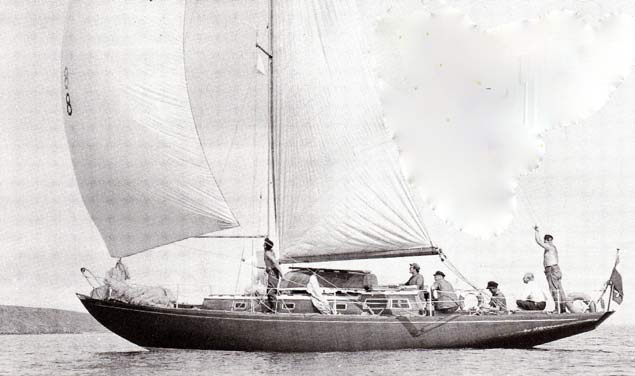 A famous victory. It is June 1966, and the 8 Metre Cruiser/Racer Orana is within yards of taking line honours and the overall win in the RORC Beaumaris-Cork Race. She carries a private breeze and the tide is with her, while most of the fleet are becalmed beyond the horizon. In savouring the moment, Orana’s crew have already put out their ensign, while crewmember Paddy Kirwan (standing at stern) is getting special enjoyment out of this very special return to his boyhood home of Cork.
A famous victory. It is June 1966, and the 8 Metre Cruiser/Racer Orana is within yards of taking line honours and the overall win in the RORC Beaumaris-Cork Race. She carries a private breeze and the tide is with her, while most of the fleet are becalmed beyond the horizon. In savouring the moment, Orana’s crew have already put out their ensign, while crewmember Paddy Kirwan (standing at stern) is getting special enjoyment out of this very special return to his boyhood home of Cork.
Subsequently he did a Fastnet Race on Orana, getting a class place, and then in due course, Paddy Kirwan had his own cruiser-racer, moving on in 1978 from the Flying Fifteen to the Ron Holland-designed Club Shamrock Boomerang. He campaigned inshore and offshore for many years, with his son Paul becoming increasingly involved, particularly after they’d moved in 1997 to the Sigma 38 Errislannan.
His enthusiasm for sailing and club life remained undimmed well into his eighties, and in his later years the Royal St George YC was added to his club list. But after he and Paul had changed from Errislannan to the new First 36.7 Boomerang in 2012, the illness which dominated his final two years began to assert itself, and his active role on board was inevitably diminished. Yet when he finally stepped ashore, it was after a long life around boats lived to the full, and many years of positive contribution to the development of our sport.
Our thoughts are with Paddy Kirwan’s children Paul, Ann, Garrett, Katy and Patrick, his wider family and grandchildren and great-grandchildren, and his many friends at this sad time.
WMN






























